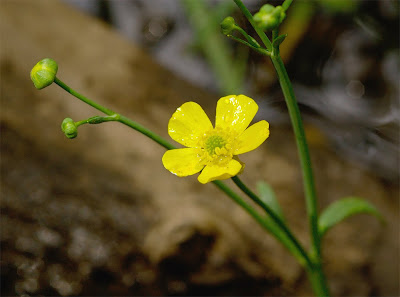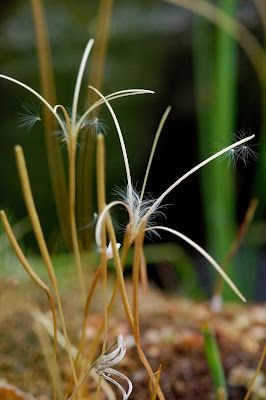This is part 2 of my camping trip: the walk home!
As I mentioned in my last post, the midges were horrific! To my horror, when I awoke, I found that my tent was BLACK with midges - all just sitting patiently on the outer surface of my tent, waiting for me to emerge.
By 10am the midges had dispersed somewhat, enabling me to pack away my tent. Burncrooks valley is one of the wildest places in the Kilpatrick Hills: the natural woodland is mainly Alder, with some Birch, Rowan and Willow, and the forest merges naturally into shrubby old-growth heather and bracken on the hills at either side. Very few people walk this way (due to the lack of any paths) so there is never any litter!
Here are some moths I found in Burncrooks valley:
 |
| Angle Shades (Phlogophora meticulosa) |
This is an Angle Shades moth in situ (above), it hasn't picked a very good hiding place. To demonstrate its brilliant bark camouflage, I moved it to a nearby Alder:
 |
| Angle Shades (Phlogophora meticulosa)
|
 |
| Angle Shades (Phlogophora meticulosa)
|
This beautiful moth is a common species and is polyphagous - meaning its larvae will eat almost all herbaceous plants. Its scientific name means 'The fearful fire-bearer' (
Phlogo = fire +
phora = to carry/bear: from Greek,
meticulosa = timorous/fearful: Latin). This probably refers to the flame-like triangular markings on the forewings.
My 'Moths of West Dunbartonshire' blog has better photos of this species (from every angle!):
http://themothzoo.blogspot.com/2010/07/angle-shades-phlogophora-meticulosa.html.
 |
| Four-dotted Footman (Cybosia mesomella)
|
 |
| Four-dotted Footman (Cybosia mesomella)
|
The Four-dotted Footman (Cybosia mesomella) is a locally distributed species in Scotland. Wing colour ranges from white (like the specimen above) to golden yellow. The larvae are thought to feed mainly on the lichens which encrust heather.
 |
| Common Heath (Ematurga atomaria) female
|
 |
| Common Heath (Ematurga atomaria) female
|
 |
| Common Heath (Ematurga atomaria) female
|
The Common Heath (Ematurga atomaria) is a day-flying moth, common in moorland areas (the larvae feed on heathers (Calluna & Erica spp.) and clovers (Trifolium spp.). Wings are very variable and can be yellow with chocolate marbling, white with chocolate marbling (as in photos above) or unicolourous chocolate brown.
.jpg) |
Silver-ground Carpet (Xanthorhoe montanata)
|
Easily disturbed from vegetation during the day, the Silver-ground Carpet (Xanthorhoe montanata) also flies at night. Look closely at this moth's wings to see the 'snowy mountain peaks' mentioned in its specific name 'montanata' (Latin).
I walked around the edge of Burncrooks reservoir and spotted some Aeshna dragonflies zooming around. Then I entered the pine plantation which borders the Kilmannan reservoir. There is a greater diversity of plant and animal species here than might be expected!
Although at first resembling an agave of some sort, this is a plantation spruce (Picea sp.) branch from above.
 |
| Spruce (Picaea sp.)
|
Spruce (Picaea sp.) needles have a very plastic astro-turf look:
 |
| Spruce (Picaea sp.)
|
Bird's-foot Trefoil (Lotus corniculatus) grows profusely at the forest edge, colonising the gravelly path when it can. It's one of the few native plants with orange flowers.
 |
| Bird's-foot Trefoil (Lotus corniculatus)
|
 |
| Bird's-foot Trefoil (Lotus corniculatus)
|
 |
| Bird's-foot Trefoil (Lotus corniculatus)
|
 |
| Bird's-foot Trefoil (Lotus corniculatus)
|
 |
| Ribwort Plantain (Plantago lanceolata)
|
Ribwort Plantain (Plantago lanceolata) is another waste-ground colonizer. One of my South American flatmates used to drink 'plantago tea' - it has medicinal qualities: the leaves are astringent/haemostatic (staunch bleeding) and the whole plant is rich in mucilage (especially the seeds) - with laxative/demulcent properties.
 |
| Large Red Damselfly (Pyrrhosoma nymphula)
|
 |
| Large Red Damselfly (Pyrrhosoma nymphula)
|
 |
| Groundsel (Senecio vulgaris)
|
 |
| Groundsel (Senecio vulgaris)
|
 |
| Groundsel (Senecio vulgaris)
|
Groundsel's scientific name (Senecio vulgaris) means 'common old-man' (Senecio = old man, vulgaris = common/widespread: Latin) and the whole plant is hepatotoxic (damages the liver) so should not be eaten.
 |
| Tormentil (Potentilla erecta) |
Tormentil has roots with a high tannin content and all parts of the plant (especially the root) are highly astringent, staunch bleeding and have antibiotic properties. Traditional uses for this plant include treatment of tooth-ache, mouth ulcers, to treat bed-wetting in children and colitis. Also, a red dye can be obtained from the roots.
I added some new plant species to my regional list: Thyme-leaved Speedwell (Veronica serpyllifolia), Heath Pea (Lathyrus linifolius) and (below) Trailing St-John's Wort (Hypericum humifusum).
 |
| Trailing St John's Wort (Hypericum humifusum)
|
 |
| Trailing St John's Wort (Hypericum humifusum)
|
 |
| Small Pearl-bordered Fritillary (Boloria selene)
|
 |
| Small Pearl-bordered Fritillary (Boloria selene)
|
Marsh Lousewort (Pedicularis palustris) grows profusely on the rocky banks of Burncrooks reservoir (South-East side, near the inflowing river).
 |
| Marsh Lousewort (Pedicularis palustris)
|
 |
| Marsh Lousewort (Pedicularis palustris)
|
 |
| Wire deer fences, rolled up
|

Around Duncolm, the rough grassland was covered with the silvery-white, feather-down seed-heads of Hare's Tail Cottongrass (
Eriophorum vaginatum).
 |
| Hare's Tail Cottongrass (Eriophorum vaginatum)
|
 |
| Hare's Tail Cottongrass (Eriophorum vaginatum)
|
 |
| Hare's Tail Cottongrass (Eriophorum vaginatum) |
 |
| Hare's Tail Cottongrass (Eriophorum vaginatum) |
 |
| Hare's Tail Cottongrass (Eriophorum vaginatum) with Duncolm behind, to left. |
 |
| Heath Spotted Orchid (Dactylorhiza maculata) |
 |
| Heath Spotted Orchid (Dactylorhiza maculata) |
In nutrient-poor bogs plants use more unusual methods to obtain food: some becoming carnivorous.
Sundews capture their prey with the aid of sticky globules secreted from leaf tentacles. When an insect becomes trapped on this sugary dew, the leaf tentacles and leaf surface begin to wrap around the insect and secrete enzymes to digest it.
The photos below are of the Round-leaved Sundew (Drosera rotundifolia) which I found growing on the boggy grassland South of Duncolm.
+2.jpg) |
| Round-leaved Sundew (Drosera rotundifolia) with flower buds |
 |
| Round-leaved Sundew (Drosera rotundifolia) with prey |
One of the sundew leaves above has already managed to trap a victim: it will supply the plant with a valuable source of nitrogen.
Here is an excellent photo demonstrating the ability of a sundew (
Drosera anglica - the largest British sundew) to tackle larger prey (damselflies):
http://commons.wikimedia.org/wiki/File:Drosera_anglica_ne2.jpg.
I stopped at the Test to have a drink and rest my tired feet. At this point I discovered that the soles were coming off my boots :(
Some nearby Blackface Sheep began making their snorting 'chirrit' alarm call at me: the sheep on the Kilpatrick Hills are almost feral and live on the moor all year round.




















.jpg)




























+2.jpg)







